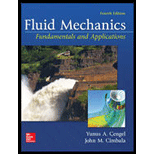
Concept explainers
The initial discharge rate of water via the pipe.
The time taken to empty the swimming pool.
The value of the friction factor.
Whether the minor loss is really minor or not.
Answer to Problem 155P
The discharge rate of water via the pipe is
The time taken to empty the swimming pool is
The given value of the friction factor is not accurate and the reasonable value of friction factor is
The value of minor loss is truly minor.
Explanation of Solution
Given information:
The swimming pool diameter is
The flow is incompressible and turbulent. The difference in elevation between the fountain and the pipe is null. The pressure at the inlet ad the exit is atmospheric in nature.
Write the expression to calculate the energy equation. Assume the effect of kinetic energy correction factor to be negligible.
Here, the inlet pressure is
Write the expression to calculate the exit velocity when time is
Here, he volume flow rate is
Write the expression for the area of cross section.
Here, the diameter of the pipe is
Substitute
Write the expression to calculate the head loss.
Here, the diameter of the pipe is
Write the expression for the elevation at any given time.
Here, the coefficient of minor loss is
Write the expression for the flow rate at any time given.
Substitute
Write the expression to calculate the water amount flowing b=via the pipe for a differential time.
Here, the differential time is
Substitute
Write the expression for the area of the tank.
Here, the diameter of the tank is
Write the expression for the decrease of volume of water in the swimming pool.
Here, the negative change in datum of tank is
Substitute
Integrate Equation (XIII) from
Write the expression to calculate the Reynolds number.
Here, the viscosity of the fluid is
Write the expression for the Colebrook equation.
Here, the friction factor is
Calculation:
Refer to Table A-3, "Properties of saturated water" to obtain the value of
The flow is fully developed making the roughness of the plastic null.
Substitute
Substitute
Consider the time is zero.
Substitute
Substitute
Convert
Substitute
Substitute
Substitute
Substitute
Hence, the value of the minor loss is truly minor as the friction factor remains unchanged.
Conclusion:
The discharge rate of water via the pipe is
The time taken to empty the swimming pool is
The given value of the friction factor is not accurate and the reasonable value of friction factor is
The value of minor loss is truly minor.
Want to see more full solutions like this?
Chapter 8 Solutions
Fluid Mechanics: Fundamentals and Applications
- (read image) (answer given)arrow_forward11-5. Compute all the dimensional changes for the steel bar when subjected to the loads shown. The proportional limit of the steel is 230 MPa. 265 kN 100 mm 600 kN 25 mm thickness X Z 600 kN 450 mm E=207×103 MPa; μ= 0.25 265 kNarrow_forwardT₁ F Rd = 0.2 m md = 2 kg T₂ Tz1 Rc = 0.4 m mc = 5 kg m = 3 kgarrow_forward
- 2. Find a basis of solutions by the Frobenius method. Try to identify the series as expansions of known functions. (x + 2)²y" + (x + 2)y' - y = 0 ; Hint: Let: z = x+2arrow_forward1. Find a power series solution in powers of x. y" - y' + x²y = 0arrow_forward3. Find a basis of solutions by the Frobenius method. Try to identify the series as expansions of known functions. 8x2y" +10xy' + (x 1)y = 0 -arrow_forward
- Hello I was going over the solution for this probem and I'm a bit confused on the last part. Can you please explain to me 1^4 was used for the Co of the tubular cross section? Thank you!arrow_forwardBlood (HD = 0.45 in large diameter tubes) is forced through hollow fiber tubes that are 20 µm in diameter.Equating the volumetric flowrate expressions from (1) assuming marginal zone theory and (2) using an apparentviscosity for the blood, estimate the marginal zone thickness at this diameter. The viscosity of plasma is 1.2 cParrow_forwardQ2: Find the shear load on bolt A for the connection shown in Figure 2. Dimensions are in mm Fig. 2 24 0-0 0-0 A 180kN (10 Markarrow_forward
- determine the direction and magnitude of angular velocity ω3 of link CD in the four-bar linkage using the relative velocity graphical methodarrow_forwardFour-bar linkage mechanism, AB=40mm, BC=60mm, CD=70mm, AD=80mm, =60°, w1=10rad/s. Determine the direction and magnitude of w3 using relative motion graphical method. A B 2 3 77777 477777arrow_forwardFour-bar linkage mechanism, AB=40mm, BC=60mm, CD=70mm, AD=80mm, =60°, w1=10rad/s. Determine the direction and magnitude of w3 using relative motion graphical method. A B 2 3 77777 477777arrow_forward
 Elements Of ElectromagneticsMechanical EngineeringISBN:9780190698614Author:Sadiku, Matthew N. O.Publisher:Oxford University Press
Elements Of ElectromagneticsMechanical EngineeringISBN:9780190698614Author:Sadiku, Matthew N. O.Publisher:Oxford University Press Mechanics of Materials (10th Edition)Mechanical EngineeringISBN:9780134319650Author:Russell C. HibbelerPublisher:PEARSON
Mechanics of Materials (10th Edition)Mechanical EngineeringISBN:9780134319650Author:Russell C. HibbelerPublisher:PEARSON Thermodynamics: An Engineering ApproachMechanical EngineeringISBN:9781259822674Author:Yunus A. Cengel Dr., Michael A. BolesPublisher:McGraw-Hill Education
Thermodynamics: An Engineering ApproachMechanical EngineeringISBN:9781259822674Author:Yunus A. Cengel Dr., Michael A. BolesPublisher:McGraw-Hill Education Control Systems EngineeringMechanical EngineeringISBN:9781118170519Author:Norman S. NisePublisher:WILEY
Control Systems EngineeringMechanical EngineeringISBN:9781118170519Author:Norman S. NisePublisher:WILEY Mechanics of Materials (MindTap Course List)Mechanical EngineeringISBN:9781337093347Author:Barry J. Goodno, James M. GerePublisher:Cengage Learning
Mechanics of Materials (MindTap Course List)Mechanical EngineeringISBN:9781337093347Author:Barry J. Goodno, James M. GerePublisher:Cengage Learning Engineering Mechanics: StaticsMechanical EngineeringISBN:9781118807330Author:James L. Meriam, L. G. Kraige, J. N. BoltonPublisher:WILEY
Engineering Mechanics: StaticsMechanical EngineeringISBN:9781118807330Author:James L. Meriam, L. G. Kraige, J. N. BoltonPublisher:WILEY





